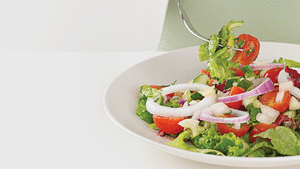Eating a low-fat salad as your first course may significantly reduce your overall kilojoule intake during a meal—an effective strategy for weight management— according to new research published in the Journal of the American Dietetic Association.
The study of American women looked at how different types and amounts of salads affected hunger, satiety and overall food intake at lunch. Eating a small salad (around one-and-a-half cups) reduced total meal kilojoule intake by 7 per cent, while eating a large salad (around 3 cups) dropped the kilojoule intake by 12 per cent!
Why Salad?
Dieters are frequently drawn to salads because they naturally contain a low level of kilojoules (unless drowned in oily dressing). Salads are also high in water content and dietary fibre, so they can fill you up while providing a relatively small number of kilojoules. This is advantageous, especially if you are on a tight kilojoule budget!
Salads supply a range of nutrients, such as vitamins, minerals and phytonutrients. The more colourful a salad, the greater the diversity of phytonutrients, which act as antioxidants to help protect against premature ageing and degenerative diseases.
What Type Of Salad?
Not all salads are helpful if you are watching your weight. Drenching a salad with full-fat dressing and sprinkling with fatty cheese may work against you. According to the research findings, eating a high-fat salad actually increases overall kilojoule intake at a meal!
Base your salad on dark green leaves, and include colour with a variety of vegetables, such as purple onion, bright red tomatoes, carrot, cucumber and crunchy sprouts. Flavoursome low-fat/kilojoule dressings are available commercially or can be made with lemon or lime juice (or balsamic vinegar) and a sprinkling of fresh herbs, such as coriander, basil and mint. For an Asian flavour, add a dash of diluted soy sauce, crushed garlic and chilli.
Click here for an exotic and delicious low-fat salad recipe.







